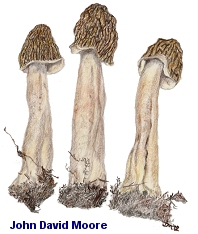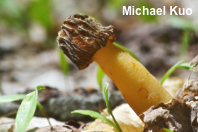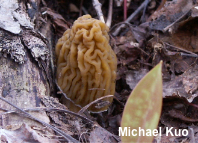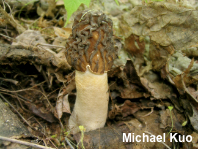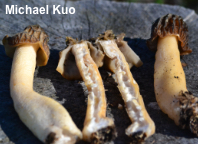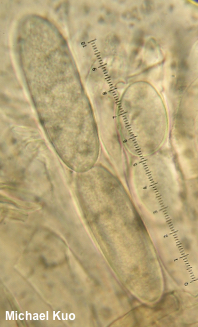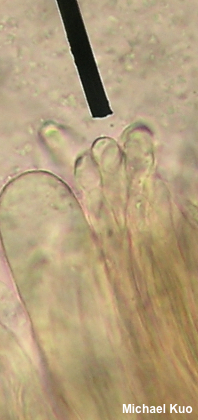| Major Groups > True Morels & Verpas > Verpa bohemica |

|
Verpa bohemica [ Ascomycota > Pezizales > Morchellaceae > Verpa . . . ] by Michael Kuo Verpa bohemica, mistakenly called the "early morel" in some areas, appears very early in the spring, and continues fruiting during the true morel season. It bears a resemblance to the half-free morels, Morchella populiphila and Morchella punctipes, but the half-free morels are exactly that—half-free—while Verpa bohemica has a cap that hangs completely free of the stem, attached only at the top. Another way to separate the two mushrooms is to cut them open; the half-free morels are hollow, while Verpa bohemica usually has cotton-candy-like wisps of flesh inside. On close inspection, the verpa has a cap that is (usually) different, as well; it tends to look wrinkled, rather than pitted (though old specimens can develop a decidedly "pitted" look). Ptychoverpa bohemica is a synonym. Description: Ecology: Probably mycorrhizal; found under hardwoods (and sometimes under conifers) in early spring; widely distributed throughout northern North America. The illustrated and described collections are from Michigan. Cap: 2–4 cm high; 1.5–3 cm across; nearly conical, or bell-shaped, or somewhat irregular; wrinkled longitudinally, sometimes appearing pitted and ridged (and then with ridges darker than pits); dry or moist; finely fuzzy or bald; tan to brown or dark yellow brown; undersurface whitish. Stem: 8–22 cm long; 1.5–3 cm thick; more or less equal, or sometimes tapered upwards or downwards; creamy white to dull yellow; sometimes discoloring orangish when handled; often featuring fine scurf that forms concentric belts. Flesh: Thin; the cap and stem are hollow, or loosely stuffed with whitish, wispy fibers (like cotton candy) in the stem. Odor and Taste: Not distinctive. Chemical Reactions: Ammonia, KOH, and iron salts negative on cap surface. Microscopic Features: Spores 48–85 x 15–24 µm; ellipsoid to elongated-ellipsoid; smooth; thick-walled; hyaline in KOH; contents homogeneous. Asci 2-spored. Paraphyses 200–300 x 5–7.5 µm; cylindric; septate; smooth; hyaline to brownish in KOH; apices rounded or subclavate. REFERENCES: (Krombholz, 1828) Schröter, 1893. (Saccardo, 1889; Seaver, 1942; Smith, 1975; Smith, Smith & Weber, 1981; Breitenbach & Kränzlin, 1984; Arora, 1986; McKnight & McKnight, 1987; Phillips, 1991/2005; Lincoff, 1992; Weber, 1995; Barron, 1999; Kuo, 2005; McNeil, 2006; Miller & Miller, 2006; Trudell & Ammirati, 2009; O'Donnell et al., 2011; Methven et al., 2013; Kuo & Methven, 2014; Siegel & Schwarz, 2016; Cripps, Evenson & Kuo, 2016.) Herb. Kuo 05249702, 05110305, 05090602, 05231405. This site contains no information about the edibility or toxicity of mushrooms. |
© MushroomExpert.Com |
|
Cite this page as: Kuo, M. (2019, May). Verpa bohemica. Retrieved from the MushroomExpert.Com Web site: http://www.mushroomexpert.com/verpa_bohemica.html |
